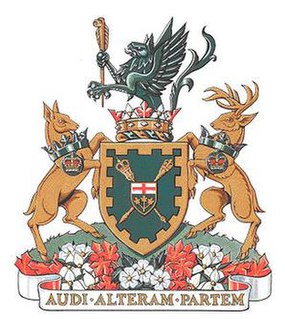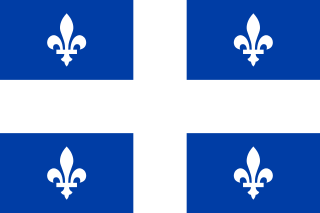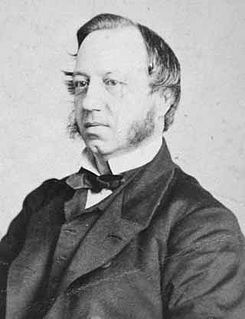
The Premier of Quebec (French: Premier ministre du Québec or Première ministre du Québec is the head of government of the Canadian province of Quebec. The current Premier of Quebec is François Legault of the Coalition Avenir Québec, sworn in on October 18, 2018 following the 2018 election.

The National Assembly of Quebec is the legislative body of the province of Quebec in Canada. Legislators are called MNAs. The Queen in Right of Quebec, represented by the Lieutenant Governor of Quebec and the National Assembly compose the Legislature of Quebec, which operates in a fashion similar to those of other Westminster-style parliamentary systems.

The Canadian federal election of 1867, held from August 7 to September 20, was the first election for the new nation of Canada. It was held to elect members to the House of Commons of Canada, representing electoral districts in the provinces of Nova Scotia, New Brunswick, Ontario and Quebec in the 1st Parliament of Canada. The provinces of Manitoba (1870) and British Columbia (1871) were created during the term of the 1st Parliament of Canada and were not part of the Canadian federal election of 1867.
The Quebec general election of 1956 was held on June 20, 1956 to elect members of the Legislative Assembly of Quebec, Canada. The incumbent Union Nationale, led by Maurice Duplessis, won re-election, defeating the Quebec Liberal Party, led by Georges-Émile Lapalme.
The Quebec general election of 1952 was held on July 16, 1952 to elect members of the Legislative Assembly of the Province of Quebec, Canada. The incumbent Union Nationale, led by Maurice Duplessis, won re-election, defeating the Quebec Liberal Party, led by Georges-Émile Lapalme.
The Quebec general election of 1948 was held on July 28, 1948 to elect members of the Legislative Assembly of the Province of Quebec, Canada. The incumbent Union Nationale, led by Maurice Duplessis, won re-election, defeating the Quebec Liberal Party, led by Adélard Godbout.
The Quebec general election of 1939 was held on October 25, 1939 to elect members of the Legislative Assembly of the Province of Quebec, Canada. The Quebec Liberal Party, led by former premier Adélard Godbout, defeated the incumbent Union Nationale, led by Maurice Duplessis.
The Quebec general election of 1935 was held on November 25, 1935 to elect members of the Legislative Assembly of the Province of Quebec, Canada. The incumbent Quebec Liberal Party, led by Louis-Alexandre Taschereau was re-elected, defeating the Action libérale nationale, led by Paul Gouin, and the Quebec Conservative Party, led by Maurice Duplessis.
The Quebec general election of 1931 was held on August 24, 1931 to elect members of the Legislative Assembly of the Province of Quebec, Canada. The incumbent Quebec Liberal Party, led by Louis-Alexandre Taschereau, was re-elected, defeating the Quebec Conservative Party, led by Camillien Houde.
The Quebec general election of 1927 was held on May 16, 1927 to elect members of the Legislative Assembly of the Province of Quebec, Canada. The incumbent Quebec Liberal Party, led by Louis-Alexandre Taschereau, was re-elected, defeating the Quebec Conservative Party, led by Arthur Sauvé.
The Quebec general election of 1923 was held on February 5, 1923 to elect members of the 16th Legislative Assembly of Quebec, Canada. The incumbent Quebec Liberal Party, led by Louis-Alexandre Taschereau, was re-elected, defeating the Quebec Conservative Party, led by Arthur Sauvé.
The Quebec general election of 1916 was held on May 22, 1916, to elect members of the 14th Legislative Assembly of the Province of Quebec, Canada. The incumbent Quebec Liberal Party, led by Lomer Gouin, was re-elected, defeating the Quebec Conservative Party, led by Philémon Cousineau.
The Quebec general election of 1912 was held on May 15, 1912 to elect members of the 13th Legislative Assembly of the Province of Quebec, Canada. The incumbent Quebec Liberal Party, led by Lomer Gouin, was re-elected, defeating the Quebec Conservative Party, led by Joseph-Mathias Tellier.
The Quebec general election of 1908 was held on June 8, 1908 to elect members of the 12th Legislative Assembly of the Province of Quebec, Canada. The incumbent Quebec Liberal Party, led by Lomer Gouin, was re-elected, defeating the Quebec Conservative Party, led by Pierre-Évariste Leblanc.
The Quebec general election of 1904 was held on November 25, 1904 to elect members of the Legislative Assembly of the Province of Quebec, Canada. The incumbent Quebec Liberal Party, led by Simon-Napoléon Parent, was re-elected, defeating the Quebec Conservative Party, led by Edmund James Flynn.
The Quebec general election of 1900 was held on December 7, 1900 to elect members of the Legislative Assembly of the Province of Quebec, Canada. The incumbent Quebec Liberal Party, led by Simon-Napoléon Parent, was re-elected, defeating the Quebec Conservative Party, led by Edmund James Flynn.

The Legislative Assembly of Ontario is one of two components of the Legislature of Ontario, the other being the Lieutenant Governor of Ontario. The Legislative Assembly is the second largest Canadian provincial deliberative assembly by number of members after the National Assembly of Quebec. The Assembly meets at the Ontario Legislative Building at Queen's Park in the provincial capital of Toronto.

The Ontario general election, 1867 was the first general election held in the newly created Province of Ontario, Canada. Previously, the territory was known as Canada West, a part of the Province of Canada. The election was held on September 3, 1867, to elect the 82 members of the 1st Legislative Assembly (MLAs). The dates of the election in 1867 varied from August 20 to September 26.
The 1st Legislative Assembly of Quebec was the first ever provincial legislature in Quebec, Canada that existed from September 1867 to June 1871, the first four years of Quebec in the Canadian Confederation. The Quebec Conservative Party led by Pierre-Joseph-Olivier Chauveau was the governing party.










